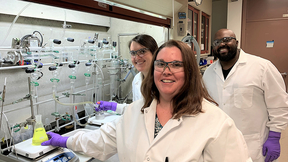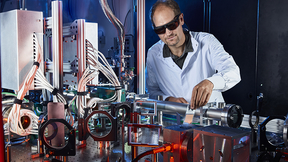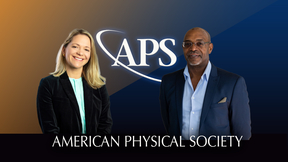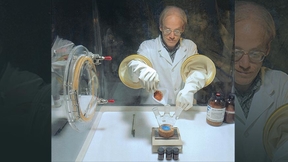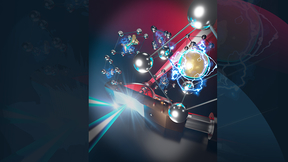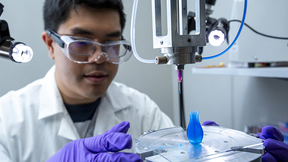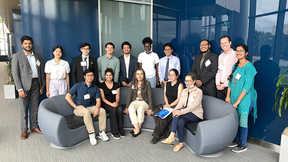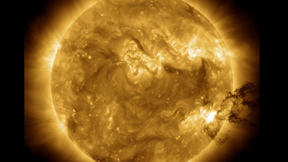Back
Physics
Novel experimental platform enables first measurements of ion-acoustic wave bursts during magnetic reconnection
A series of experiments conducted at the Omega Laser, part of the University of Rochester’s Laboratory for Laser Energetics, provide new insights into magnetic reconnection, a process that could help explain stellar flares and other astrophysical phenomena. The research confirmed that unstable ion-acoustic waves (IAWs) could be important to further understanding of the…
Illuminating the science of black holes and gamma-ray bursts using high-power lasers
High-power lasers now create record-high numbers of electron-positron pairs, opening exciting opportunities to study extreme astrophysical processes, such as black holes and gamma-ray bursts. Positrons, or "anti-electrons," are anti-particles with the same mass as an electron but with opposite charge. The generation of energetic electron-positron pairs is common in extreme…
Five Lab teams recognized with Secretary’s Honor Achievement Awards
Lawrence Livermore National Laboratory (LLNL) employees, participating in five project teams, recently earned Department of Energy (DOE) Secretary’s Honor Achievement Awards. Representing some of the highest internal, non-monetary recognition that DOE employees and contractors can receive, the Secretary’s Honor Awards recognize DOE employees and contractors for their…
Improving precision of pressure determination in nanosecond X-ray diffraction experiments
X-ray diffraction measurements under laser-driven dynamic compression allow researchers to investigate the atomic structure of matter at hundreds of thousands of atmospheres of pressure and temperatures of thousands of degrees, with broad implications for condensed matter physics, planetary science and astronomy. Pressure determination in these experiments often relies on…
Iron under Extremes
Lawrence Livermore scientists have performed a series of experiments through the National Ignition Facility’s (NIF’s) Discovery Science Program to replicate the extreme conditions within super-Earth cores and answered many questions posited by theoretical predictions and extrapolations from previously established relatively low pressure–temperature experimental data.
Uranium takes an alternate pathway under extreme conditions
Under normal conditions, radioactive materials such as uranium work in a predictable manner. But take those same materials and put them under extreme conditions with high temperature in a short timescale and a rapid cooling process and their decomposition pathways change dramatically. Lawrence Livermore National Laboratory (LLNL) scientists built a unique process to…
'Twisted' laser light experiments offer new insights into plasma physics
Electromagnetic vortices occur naturally throughout the universe and have recently been observed in association with black holes. Over the last decade, scientists have sought methods to investigate how extremely strong electromagnetic vortices interact with matter, specifically plasma, in a laboratory setting. Plasma, known as the “fourth state of matter,” makes up nearly…
Two LLNL scientists selected as 2022 APS fellows
Two Lawrence Livermore National Laboratory (LLNL) scientists have been selected as 2022 fellows of the American Physical Society (APS). Physicists Andrea (Annie) Kritcher and Ronnie Shepherd were both selected by the APS Division of Plasma Physics. APS fellowships are awarded after extensive review and are considered a distinct honor because the evaluation process,…
Kraus honored for inaugural American Physical Society award
Lawrence Livermore National Laboratory (LLNL) research scientist Richard Kraus is the recipient of the inaugural American Physical Society’s 2023 Neil Ashcroft Early Career Award for Studies of Matter at Extreme High Pressure Conditions. Kraus is recognized for his outstanding theoretical or experimental contributions by an early-career scientist to studies of matter at…
The people of stockpile stewardship are the key to LLNL’s success
The last nuclear test, code-named Divider, took place 30 years ago, on Sept. 23, 1992. That year, President Bush declared a temporary moratorium on nuclear testing, which became permanent during the Clinton administration. This ending of the era of nuclear testing was also the beginning of stockpile stewardship. Leaders from the Department of Energy (DOE), and Lawrence…
Scientific discovery for stockpile stewardship
Scientific discovery during the Stockpile Stewardship Program maintains confidence in the nuclear deterrent without testing, brings other benefits The last nuclear test, code-named Divider, took place 30 years ago, on September 23, 1992. That year, President Bush declared a temporary moratorium on nuclear testing, which became permanent during the Clinton administration…
Developing technology to keep the nuclear stockpile safe, secure and reliable
The last nuclear test, code-named Divider, took place 30 years ago, on Sept. 23, 1992. That year, President Bush declared a temporary moratorium on nuclear testing, which became permanent in 1995, during the Clinton administration. This ending of the era of nuclear testing coincided with a Presidential announcement of the beginning of stockpile stewardship. As the decision…
Under pressure: solid matter takes on new behavior
Investigating how solid matter behaves at enormous pressures, such as those found in the deep interiors of giant planets, is a great experimental challenge. To help address that challenge, Lawrence Livermore National Laboratory (LLNL) researchers and collaborators took a deep dive in understanding these extreme pressures. The work was just published in Nature Physics with…
Burning Plasma Team receives honor from American Physical Society
The Burning Plasma Team has been awarded the 2022 John Dawson Award for Excellence in Plasma Physics Research by the American Physical Society. The team consists of members from Lawrence Livermore National Laboratory (LLNL) and from other institutions. The team was cited “for the first laboratory demonstration of a burning deuterium-tritium plasma where alpha heating…
A deep dive into the interior of red dwarfs
Red dwarfs are the most abundant stars in the Milky Way, making up 70% of all stars. But the physics of their interiors is not well understood. Heat is generated in the core and travels outward to the surface, but it is not clear whether that process occurs via radiation, convection or a combination of the two. The key factor determining whether red dwarfs are radiation-…
LLNL hosts HBCU students, faculty in week-long outreach program
Lawrence Livermore National Laboratory (LLNL) hosted a group of students and faculty from Historically Black Colleges and Universities (HBCUs) for a week in June to promote internships, job opportunities and career paths at LLNL. Judging from the group’s reaction and feedback, the inaugural week-long HBCU tour was a clear success and made a positive impression on the…
Livermore researchers collect three awards among the top 100 industrial inventions
Lawrence Livermore National Laboratory (LLNL) scientists and engineers have garnered three awards among the top 100 industrial inventions worldwide. The trade journal R&D World Magazine recently announced the winners of the awards, often called the “Oscars of invention,” recognizing new commercial products, technologies and materials that are available for sale or…
LLNL and Case Western Reserve University to continue collaboration
The leaders of Case Western Reserve University and Lawrence Livermore National Laboratory (LLNL) signed a memorandum of understanding (MOU) to accelerate their efforts in shared areas of excellence. After three years of growing institutional collaboration in such areas as energy, materials science and polymer processing, Case Western Reserve President Eric W. Kaler…
Three peer-reviewed papers highlight scientific results of National Ignition Facility record yield shot
After decades of inertial confinement fusion research, a yield of more than 1.3 megajoules (MJ) was achieved at Lawrence Livermore National Laboratory’s (LLNL’s) National Ignition Facility (NIF) for the first time on Aug. 8, 2021, putting researchers at the threshold of fusion gain and achieving scientific ignition. On the one-year anniversary of this historic achievement,…
Short Wavelengths Yield Big Dividends
Collaborative research and development focused on the extreme ultraviolet (EUV) end of the spectrum has resulted in state-of-the-art, multilayer reflective optics used for space exploration, manufacturing microchips, and more.







